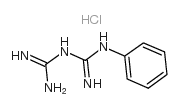1-phenylbiguanide hydrochloride

1-phenylbiguanide hydrochloride structure
|
Common Name | 1-phenylbiguanide hydrochloride | ||
|---|---|---|---|---|
| CAS Number | 55-57-2 | Molecular Weight | 213.66700 | |
| Density | 1.33g/cm3 | Boiling Point | 388.4ºC at 760mmHg | |
| Molecular Formula | C8H12ClN5 | Melting Point | 244-247ºC(lit.) | |
| MSDS | Chinese USA | Flash Point | 188.7ºC | |
| Symbol |

GHS07 |
Signal Word | Warning | |
|
Indian red scorpion venom-induced augmentation of cardio-respiratory reflexes and pulmonary edema involve the release of histamine.
Toxicon 57(2) , 193-8, (2011) Pulmonary edema is a consistent feature of Mesobuthus tamulus (MBT) envenomation. Kinins, prostaglandins and other inflammatory mediators are implicated in it. Since, histamine also increases capillary permeability, this study was undertaken to evaluate wheth... |
|
|
Effect of 3,5-dicarbomethoxyphenylbiguanide on free radical homeostasis in rats with experimental myocarditis.
Bull. Exp. Biol. Med. 154(2) , 192-5, (2012) Administration of 3,5-dicarbomethoxyphenylbiguanide to rats with experimental epinephrine-induced myocarditis was followed by a decrease in activity of marker enzymes for cardiomyocyte cytolysis in the blood serum. This agent also decreased the intensity of f... |
|
|
B(2) kinin receptors mediate the Indian red scorpion venom-induced augmentation of visceral reflexes via the nitric oxide cyclic guanosine monophosphate pathway.
Acta Physiol. (Oxf.) 196(4) , 365-73, (2009) This study was performed to delineate the kinin (receptor)-dependent pathways in the Indian red scorpion (Mesobuthus tamulus; MBT) venom-induced pulmonary oedema as well as the augmentation of cardio-pulmonary reflexes evoked by phenyldiguanide (PDG).In ureth... |
|
|
Modulation of cardiopulmonary depressor reflex in nucleus ambiguus by electroacupuncture: roles of opioids and γ-aminobutyric acid.
Am. J. Physiol. Regul. Integr. Comp. Physiol. 302(7) , R833-44, (2012) Stimulation of cardiopulmonary receptors with phenylbiguanide (PBG) elicits depressor cardiovascular reflex responses, including decreases in blood pressure and heart rate mediated in part by the brain stem parasympathetic cardiac neurons in the nucleus ambig... |
|
|
Activation of NTS A(1) adenosine receptors inhibits regional sympathetic responses evoked by activation of cardiopulmonary chemoreflex.
Am. J. Physiol. Regul. Integr. Comp. Physiol. 303(5) , R539-50, (2012) Previously we have shown that adenosine operating via the A(1) receptor subtype may inhibit glutamatergic transmission in the baroreflex arc within the nucleus of the solitary tract (NTS) and differentially increase renal (RSNA), preganglionic adrenal (pre-AS... |
|
|
Mechanisms underlying the augmentation of phenylbiguanide and capsaicin induced cardiorespiratory reflexes by Mesobuthus tamulus venom.
Pulm. Pharmacol. Ther. 25(5) , 383-91, (2012) Phenylbiguanide (PBG) and capsaicin evoke cardiorespiratory reflexes utilizing two separate pathways. It is known that Indian Red Scorpion (Mesobuthus tumulus; MBT) venom augments PBG (5-HT(3)) responses but, the effect of MBT venom on capsaicin (TRPV1)-induc... |
|
|
Excitability of small-diameter trigeminal ganglion neurons by 5-HT is mediated by enhancement of the tetrodotoxin-resistant sodium current due to the activation of 5-HT(4) receptors and/or by the inhibition of the transient potassium current.
Neuroscience 157(3) , 683-96, (2008) The aims of the present study were to investigate whether the activation of the 5-HT receptor subtypes (5-HT(4) and 5-HT(3)) acted significantly on the modification of the tetrodotoxin-resistant sodium current (I(NaR)) in small-sized rat trigeminal ganglion (... |
|
|
Study of 5HT3 and HT4 receptor expression in HT29 cell line and human colon adenocarcinoma tissues.
Arch. Iran. Med. 13(2) , 120-5, (2010) Serotonin (5HT) has been shown to be a mitogenic factor in several carcinomas. Its mitogenic effect is elicited through a wide range of 5HT receptor subtypes. In this study, the effects of 5HT, 5HT3 (1-phenylbiguanide hydrochloride) and 5HT4 (cisapride) agoni... |
|
|
Involvement of phospholipase A2 pathway for the Indian red scorpion venom-induced augmentation of cardiopulmonary reflexes elicited by phenyldiguanide.
Neurosci. Lett. 440(3) , 242-5, (2008) The present study was conducted to examine the role of phospholipase A(2) and prostaglandins in Indian red scorpion (Mesobuthus tamulus; MBT) venom-induced augmentation of cardiopulmonary reflexes elicited by phenyldiguanide (PDG). Trachea, femoral artery and... |
|
|
The effects of catalase inhibition into the fourth cerebral ventricle on the Bezold-Jarisch reflex in spontaneously hypertensive rats.
J. Integr. Neurosci. 10(4) , 475-87, (2011) Many studies have investigated the role of oxidative stress on cardiovascular system in the brainstem of spontaneously hypertensive rats (SHR). However, we do not know yet if catalase inhibition influences cardiopulmonary reflex (Bezol-Jarisch reflex). Thus, ... |